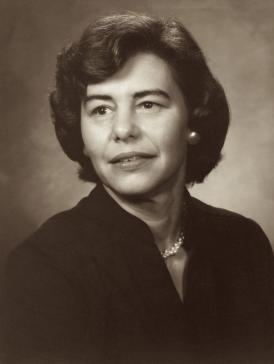The First Woman Dean
Joan S. Stark was appointed as the SOE’s fifth dean and first woman to hold the position on March 17, 1978. Stark assumed the deanship as the school was preparing to celebrate the centennial of the establishment of the first permanent American chair of education. As her tenure began, education was once again under attack. Escalating education costs and the oversupply of teachers prompted criticism and pressure for change. As the new dean noted in her first annual report, education was once again called upon to justify how it contributed “to the maintenance of an educated and productive citizenry.”
Several organizational changes were instituted to meet programmatic needs and to refocus the School in an era of declining resources. The Department of Physical Education, established in 1976, became the School’s fifth division. The Speech and Hearing Sciences program, transferred from the Medical School in 1978, was integrated into the Special Education program. Over 50 underutilized courses were deleted from the curriculum. The undergraduate program in vocational education was phased out, and the Fresh Air Camp at Patterson Lake closed.

Research excellence in a few select areas emerged as the new emphasis. Stark stressed research as an ongoing activity, and research proposals became more focused on the mission of the school. Adult learning, policy development, and technology became research foci. A research incentive plan was implemented, and merit increases and promotions became tied to scholarly productivity. Research retreats and seed money focused research and fostered interdisciplinary collaboration.
As the school began to move in new directions, dwindling enrollment and campus-wide budget constraints placed it under heightened scrutiny. A $12 million shortfall in state appropriations for the University’s 1981-82 budget prompted the announcement of a five-year plan to balance the budget through a 10 percent university-wide reduction and the termination or downsizing of select campus units. The three units identified as candidates for major reduction were the School of Education, the School of Art, and the School of Natural Resources.
A review committee was appointed in April 1982 to evaluate the quality and size of the SOE. The committee reviewed 10 volumes of data and 200 exhibits submitted by the School, held four public hearings, and conducted interviews with school of education deans from other universities. Their report, released in March of 1983, contained 18 recommendations resulting in a 40 percent reduction over five years.
Shortly after the last public hearing on the SOE was held, the National Commission on Excellence in Education released the highly publicized report A Nation at Risk: The Imperative for Educational Reform. The report decried a “rising tide of mediocrity” and the deterioration of American education which threatened “our very future as a nation and a people.” Wide-ranging educational reforms were called for, including improvement in teacher preparation programs. Statistics on the growing number of functionally illiterate Americans gave credence to the assertions. Despite the widespread publicity surrounding the oversupply of teachers, the commission reported severe shortages of qualified teachers in mathematics, science, and foreign languages. The Nation at Risk report, widely read and discussed, likely influenced the decision over whether or not to reduce the SOE.